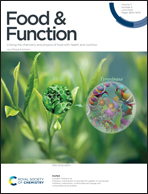Pelargonidin ameliorates CCl4-induced liver fibrosis by suppressing the ROS-NLRP3-IL-1β axis via activating the Nrf2 pathway
Abstract
Liver fibrosis is a histological change that often occurs due to hepatic stellate cell (HSC) activation and excessive formation of an extracellular matrix in the liver. Pelargonidin (PEL) is a natural anthocyanidin existing in blueberries, berries, strawberries, and red radishes and has been demonstrated to possess health beneficial effects. Herein, we investigated the effect of PEL on liver fibrosis induced by CCl4 and hepatic stellate cells induced by transforming growth factor-β (TGF-β). We found that PEL administration prevented liver injury and liver fibrosis induced by CCl4 in a dose-dependent manner. Further data revealed that PEL increased liver nuclear factor E2-related factor 2 (Nrf2) and reduced liver oxidative stress and the expression levels of NLRP3, caspase-1 and IL-1β. In TGF-β-challenged HSCs (LX-2 cells), PEL effectively inhibited the LX-2 cell activation. In addition, the anti-fibrosis effects of PEL in LX-2 cells were abolished by Nrf2 knockdown. In summary, our study demonstrated that PEL ameliorated CCl4-induced liver fibrosis and HSC activation induced by TGF-β. The possible molecular mechanisms of PEL in liver fibrosis may be attributed to its suppression of ROS-NLRP3-IL-1β signaling by Nrf2 activation.



 Please wait while we load your content...
Please wait while we load your content...